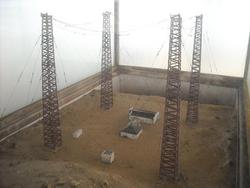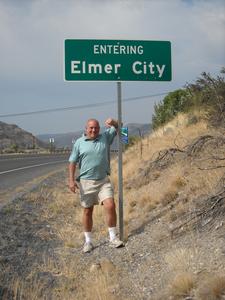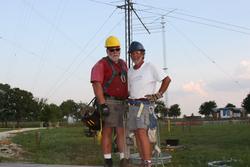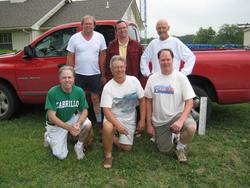 September 16, 2009 Editor: Ward Silver, NØAX | ||||||
IN THIS ISSUE
NEW HF OPERATORS - THINGS TO DO We're really getting into the fall contest season now! The approaching equinox makes for some rapid and often welcome changes to HF propagation. For a special treat, get on the air as the terminator sweeps across your longitude and see what north-south grey-line paths come alive. Fall propagation combined with a big contest like CQ WW RTTY can be an awful lot of fun! BULLETINS There are no bulletins in this issue. BUSTED QSOS CONTEST SUMMARY Complete information for all contests follows the Conversation section Sep 19-20
Sep 26-27
NEWS, PRESS RELEASES, AND GENERAL INTEREST How many counties? Let's just say Texas has a LOT of counties (256) and about the only chance you have of snagging the mavericks of the lot is during this weekend's Texas QSO Party. Roving ham-a-dillos will be scurrying their way around the state, so clean your RF sharpshooter and prepare to rope in a herd of QSOs! Texas has a great tradition of mighty mobiles motoring madly through this gi-normous state, so get ready to peel off that Texas state flag sticker for your Year Of the State QSO Party certificate! Warm up with the Washington and South Carolina events the preceding weekend. Oenophiles are also tuning up for the California QSO Party (CQP), coming to a radio near you October 3rd and 4th with vintage fruit-of-the-vine prizes and many certificates. It's the oldest, biggest and most popular state QSO party on the planet. California is a big state and many of its counties are harder to find than Cycle 24 sunspots most of the time. If you're a native, why not get out there and activate one? Register on the CQP Web site or take a look to see who will be putting out the ones you need for the WACC award. There's lots of action - single-op, multi-op, CW, and SSB - all sponsored by the Northern California Contest Club (NCCC)!
A couple of issues back, I reported a "clean sweep" for the Year Of the State QSO Party, but I'd overlooked the Alaskans! Luckily, a special event was already in the works that will suffice for lifting the sticker that bears the Big Dipper on a field of navy blue. Corliss AL1G writes, "The Alaska 50th Anniversary of Statehood Special Event will be on the air October 18, 2009 from 1800Z until October 19, 2009, 0600Z. There will be fifteen or more stations on from around the state of Alaska all using KL5O...on all bands and modes, from 160 through 10 meters, including the WARC bands." OK, now we have every one on the air - go get 'em! There is plenty of contest logging software for Windows⢠users, but what about software for Macintoshâ¢-based contesters? Frankly, there aren't nearly as many programs available, but MacLoggerDX is one such package. Late-model Macs can also use PC software within a Virtual Machine (VM) or one of a number of utilities that boot up your Mac as a PC. An often-overlooked solution, though, is to simply purchase an inexpensive used laptop and dedicate it to logging software. (Thanks, Tom K1KI and Dave KM3T) Rovers were out in force for last weekend's ARRL September VHF QSO Party, but how about the "extreme roving" of the off-road, 4x4 mobile hams? This organization is all about "off the road and on the air"! In more good news for 40 meter fans, the IARU Region 1 Web site is reporting that Radio China is planning to stop broadcasting between 7.1 and 7.2 MHz in accordance with the updated international treaty. This will free up several channels for the West Coast operators that haven't reaped the benefits experienced in the Midwest and on the East Coast. If the "big dog" is moving, we can hope that perhaps other East Asian SW BC stations will follow that audience to new frequencies, too! Pete N4ZR reports that "While nobody was looking, the World HF Contest Station Database passed the 3500-station mark and stands today at 3581. Have you updated your record to reflect changes in your station? It's amazing how many K3s are turning up in the last few months. You can find out how many by using one of the specialized search options."
The first of the broadcasting services, the AM station, may be in its twilight as reported in this Radio World article. AM's automotive market is being eroded by FM and the newer satellite-based services. Fewer folks are tuning in at home, as well. Listening to evening thunderstorms season the baseball play-by-play with a crackle of static as you sip a cold 807 and watch moths flutter against the screen may be going the way of the Sunday doubleheader and Lake Erie swing! (Thanks, Tim K3LR) Dean W9WGV has discovered what may be the first QST piece complaining about messy Morse on the airwaves. In the May 1916 issue (page 98 - available to ARRL members via the on-line QST Archives), The Old Man (Hiram P Maxim's nom de plume) was grousing about the use of abbreviations over spark in those days. Have things changed with today's precision keyers? They do exactly what they're told, but they still have to be told the right things, such as prosigns being one character without spaces. The more things change... I'm sure you saw the story about the bandwidth of a carrier pigeon being greater than that of the South African Internet. Well, there's a technical standard that covers just such protocols: RFC 1149, published on April 1, 1990, "A Standard for the Transmission of IP Datagrams on Avian Carriers". You didn't think they were just going to wing it, did you? (Thanks, Rus K2UA) Web Site of the Week - KB1LQD and KB1LQC have put together a badly-needed Web site for college clubs - CollegeARC. "We have created a new interactive Web site to serve the college amateur radio community. We aim to provide a great resource to the community by sharing information of these clubs between each other, to the amateur radio community, and to the general public. CollegeARC will provide not only an interactive way for the college amateur radio clubs and operators to communicate, collaborate, and share their experiences but also provide a needed resource of relevant information for clubs to grow." After you've browsed the site, if you're an alumnus of a college or university club, take a moment to encourage their participation in the ARRL November Sweepstakes School Club competition and the Collegiate ARC Championship. WORD TO THE WISE The Box - "Making the box" is not a shadow puppet technique or enclosure assembly instruction, it's getting your score into the featured listings of the contest results, usually as one of a category's Top Ten. It's certainly rewarding, especially that first time! Be careful, though - once you've "made the box", then you have to worry about staying there! SIGHTS AND SOUNDS Here is a thought-provoking video called "Did You Know?" about the changes of scale both in and caused by technology at an ever-accelerating pace. (Thanks, Linda Couser) RESULTS AND RECORDS Harry RA3AUU writes to let us all know that RDXC-2009 final results are available. These were the last set of contest results that will count for the WRTC-2010 qualification process. The process of evaluating applications for operating in next summer's WRTC can now begin.
Here's a great new scores database put together by brothers SP9LJD and SP9UON. Enter your (or anyone's) call sign into ContestRank and up pops your results in contests going back to 2000 plus data about how your score compares with the average contest score in each contest. It currently covers 70 different contests. (Thanks also, Jerry KA8Q) Results have been available for the 2009 Spring VHF and Up Sprints since last month. (Thanks, Chuck N6KW) OPERATING TIP If your eyeglasses and headphones are working together to push your temples into your frontal lobes during long contests, take a look at the new ear buds for music players. The fidelity and comfort of these small earpieces has improved dramatically over the past few years. You can also wear noise-canceling headphones over them while hardly noticing. (Thanks, Paul W8AEF) TECHNICAL TOPICS AND INFORMATION Software-defined radio (SDR) is by no means an amateur-only undertaking as can be seen at the commercial-professional SDR Forum Web site. Learn what other applications are making the SDR leap! (Thanks, Jim K9JWV) Another in the burgeoning Do-It-Yourself population of Web pages for the hands-on among us is the Hackaday site. Such a "new" definition of hacking moves out of the realm of malware and back towards the original honorable intent of being capable and resourceful. If you are teaching a licensing course or learning the material yourself, a dynamic demonstration is often the key to understanding. ARRL COO Harold WJ1B has been teaching license classes to unlicensed employees at ARRL HQ and recommends the math, physics, and electronics simulations and applets on the Web pages of Paul Falstad, Cuthbert Nyack, and Walter Fendt as particularly good. Many software programs have drawing tool sets for simple graphics, but once the project gets the slightest bit complicated, a "real" CAD program is required. The Cademia program is an open-source CAD package suitable for all sorts of mechanical drawing tasks without requiring the casual user to pay for a professional product, although "pro" version is also available. (Thanks, Bill Rubin)
You can control any Tailtwister⢠or HAM-M⢠rotator with multiple control boxes after a couple of minor modifications. (This will not work with the DCU-1 or digital controllers.) Designate one control box as the primary control box. In the secondary control box (or boxes) remove the 1/8th-amp fuse from the meter board. Connect terminals 1, 2,3, 5, 6, and 7 in parallel between both control boxes, leaving terminals 4 and 7 unconnected on the secondary control box. The "brake" LED will light on both boxes whenever any box is in use - do not attempt to move the antenna if the brake light is on! It is best if both boxes are connected to the same power circuit (breaker) but it is not necessary if precautions are taken to prevent simultaneous operation. (Thanks, Joe W4TV) A September 2009 Popular Mechanics story about rebuilding in New Orleans featured the Power Grip⢠pipe wrench that combines gripping, ratcheting, clamping, and one-handed operation. (There's also a nut-wrench.) Having wished for a tool like this during tower climbs and around the house and garage, it caught my eye right away. On page 110 of the same issue, a hint-and-kink shows how baby bottle nipples can make a great water-sealing boot for cables or switches. Removing flux from PC boards and other soldered connections is important for low-power and sensitive applications, as well as those exposed to moisture that might be absorbed by the organic residue. Mike WEØH uses ISO-Heat⢠gasoline anti-freeze. It's 100% isopropyl alcohol and as an automotive product, costs less than the same compound packaged as a specialty flux remover. ISO-Heat (in the red bottle) should not be confused with Heat⢠(in the yellow bottle) - that's methyl (wood) alcohol and unsuitable as a flux remover. In another "re-purposing" of a non-radio product, Brad AA1IP has discovered an adhesive product called "Zotsâ¢" at the local fabric store. The Zots consist of blobs of clear adhesive backed by a waxed-paper tape. Touch a Zot to the point of adhesion and peel away the paper, leaving the other adhesive surface exposed. These should be ideal for reattaching rubber feet to cabinets, applying cabinet trim, and so forth. They are inexpensive and so can be used as temporary hold-in-place helpers. The Battery Tool Kit Web page by John AE5X has gotten another update and now includes projects such as a Battery Booster, a Battery Voltage Monitor for 6 V & 12 V, Battery Chargers based on the QRPme.com PTO kit, and a Self-Powered 12V Battery Desulfator. John also sent a link pertaining to battery maintenance. Jim K9YC sends word of the release of the third edition of Henry Ott's book on Electromagnetic Compatibility (EMC), an authoritative reference in the field. Jim particularly recommends this book because of Ott's approach to problems through the fundamentals, breadth of understanding, and clarity of explanations. It's not for light reading, but anyone with a serious interest in the field will want a copy on the bookshelf. Technical Web Site of the Week - The Mother of All Swiss Army Knife software packages, HAMCALC, is now at version 112 and counting, having added calculations for Helical Resonators, Insertion Loss, Transmission Line Mismatch, Long-Tailed Pairs, and Pi and T networks. A tip of the Contest Update cap to author George, VE3ERP! CONVERSATION The Thrill Of the Hunt More exciting than a DX QSO, better than finding that lost tool, even approaching the buzz of a Sweepstakes Clean Sweep, is the thrill of the hardware store hunt! There's really nothing to get the creative and primal juices flowing like entering a legal-limit-sized home improvement emporium, knowing that you're going to walk out with the makings of another fine ham radio gadget, even though there is nothing anywhere inside intended for use on the ham bands! Saturday's quarry was the necessary pieces to build a portable antenna - a 6-meter dipole to be exact - in such a way that I would have a super-duper antenna holder-upper for envisioned rambles across the latitudes and longitudes of this great land. A dipole today, but a veritable Swiss Army knife of skyhook deployment tomorrow! In my mind's eye, I had the vision. In my pocket, I had the credit card. As the adrenaline kicked in, appearing across the wide, well-stocked savannah was aisle six - Plumbing! Beginning with the radiator, I first stalked the wily herds of ½" copper tubing. In my head, I recited the magic incantation, "four-sixty-eight divided by fifty is nine-feet-four" and wondered if I could get a ten-foot piece in the car. But wait, just down the row and only a few cents more were two five-foot pieces. I drew my arm back and struck ruthlessly -- my first prey and I hadn't been in the wild, er, store for two minutes! Swiveling panther-like, I glided wordlessly into the flocks of PVC adapters. Evading elbows, confounding couplers, rejecting reducers, I tiptoed to the tees and found to my utter disgust that ½" tubing and a ½" slip tee shared only the barest of diametrical resemblances. ¾", you say? "Ho," I heard the plumbing gods snicker, "not so easy, is it, antenna boy?" Blood pulsing hot at my temples, the copper adaptors were perused and a threaded male plucked from its burrow. Yet the gods toyed with me once more - there were no all-threaded plastic tees. Zounds! Adapting my design as well as the diameters, I determined that the resulting friction fit would be fine if secured with a machine screw -- stainless steel, of course. I pressed on. I had captured the center insulator, a PVC tee, and the radiating element, two slightly oversized and trimmable lengths of purest copper with a pair of adapters and all the necessary fasteners. The lot piled high in my game bag (it looked amazingly like a plastic shopping cart) I turned to the most difficult of required tasks - obtaining a reasonably-priced and sturdy extendable pole of no less than 12 feet, preferably 15 or more. Slinking deep within the shadows, I quickly moved to Paint. Quickly, because the morning's coffee was beginning to make its presence felt and I knew my time was short!
There in a standalone display was an well-stocked selection of Fine Business snap-locking paint poles, but egads -- $40? Nay, I said, and nay again! I knew that somewhere In the Home Improvement Forest lurked a bargain. These were but a high-priced decoy for the unwary and impulsive! Ignoring the coffee, I considered my options. A pool cleaning net? A cobweb duster? Slowly, a vision formed ...of ...of ...broomsticks! Yes! The housewares aisle! That fertile vale of volume discounts and limited budgets. Stealthily, I peeked between copses of stepstools and mops to spy extensible poles for push brooms! 16 feet for $30, oh frabjous day of delectation! And into the basket it went. Oh, but the gods of the hunt were not through with this pitiful and flummoxed mortal. In one awful trice, victory was snatched back as I realized the tee's remaining orifice and the upper fitting of the pole were as oil-and-water! My ears burned as I wheeled my basket out into the main aisle and scanned the contents of the aisles, from lumber at one horizon to the foothills of home furnishings on the other. The accumulated coffee spake softly, and then less softly, as my eye fell on the cruel beauty of Irrigation! Ignoring the pleadings of the accumulated morning's quaffery, I made a bee-line for that rack of black and brass inscrutia. As if in reward, a 3/8" MIPT barbed fitting flew into my hand, its perfect fit to both tee and pole signaling the end of my hunt! My joy was tempered by the furrowed brow of a fellow hunter transfixed nearby before the arrayed infinitude. I recognized his plight instantly. "Watcha looking for?" I offered in the natural ritual of bonding. "They haven't got it," he grimaced. "All I need is this (pointing here) with a female adapter! (pointing there)" I nodded in sympathy, acknowledging his anguish. We both knew that he could, in fact, assemble a cascade from this to that, but it would be an Unclean Kluge, offensive in his sight until the end of his days. And worse, his brother-in-law would see it and ask (over and over) why he didn't just use an 88-cent Thelman Fitting? We both sighed in synchrony then I murmured the timeless benediction, "Mmmm-hmm. Well, good luck, then..." and left him to his fate, cap pushed back on his head, broken part in hand, a hardware Diogenes searching endlessly for a part he'd never find. With not a moment to lose and brandishing my plastic talisman, I was rung up and free. After a quick and welcome pit stop, I emerged into the sunlight, bearing the parts and pieces for the afternoon's assembly. It was a good day and a good hunt with a story to be told around the Saturday morning breakfast table to elder and callow youth alike. May your tales be as tellable, too - and happy hunting! CONTESTS 16 September to 29 September An expanded, downloadable version of QST's Contest Corral in PDF format is available. Check the sponsor's Web site for information on operating time restrictions and other instructions. HF CONTESTS Scandinavian Activity Contest--CW, from Sep 19, 1200Z to Sep 20, 1200Z. Bands (MHz): 3.5-28. Exchange: RST and serial. Logs due: Oct 31. Rules CIS DX Contest--CW,Digital, from Sep 19, 1200Z to Sep 20, 1200Z. Bands (MHz): 1.8-28. Exchange: RST and CIS area code or serial. Logs due: 30 days. Rules South Carolina QSO Party--Phone,CW,Digital, from Sep 19, 1300Z to Sep 20, 2100Z. Bands (MHz): 3.5-28, 50+, Frequencies: CW--1.805, 50 kHz above band edge; Phone--1.845, 3.86, 7.261, 14.27, 21.37, 28.37. Exchange: RS(T) and county or S/P/C. Logs due: Oct 20. Rules Washington State Salmon Run--Phone,CW,Digital, from Sep 19, 1600Z to Sep 20, 2400Z. Bands (MHz): 1.8-28, 50. Exchange: RS(T) and county or S/P/C. Logs due: Oct 31. Rules Feld-Hell Monthly Sprint--Digital, from Sep 19, 1700Z to Sep 19, 2000Z. Bands (MHz): 1.8-28. Exchange: RST, S/P/C, Feld-Hell member number. Rules QCWA Fall QSO Party--Phone,CW,Digital, from Sep 19, 1800Z to Sep 20, 1800Z. Bands (MHz): 1.8-28, 50+. Exchange: Call sign, year lic'd, name, chptr or S/P/C. Logs due: 30 days. Rules North American Sprint--Phone, from Sep 20, 0000Z to Sep 20, 0400Z. Bands (MHz): 3.5-14. Exchange: Call signs, serial, name, and state. Logs due: 7 days. Rules Classic Exchange--CW, from Sep 20, 1300Z to Sep 21, 0700Z. Bands (MHz): 1.8-28, 50,144, Frequencies: 1.820, 3.545, 7.045, 14.045, 21.135, 28.05, 50.1, 144.1. Exchange: Name, RS, S/P/C, type of equipment. Logs due: 60 days. Rules CQ WW RTTY Contest--Digital, from Sep 26, 0000Z to Sep 27, 2400Z. Bands (MHz): 3.5-28. Exchange: RST, CQ zone and State/VE area (US/VE). Logs due: Nov 1. Rules Scandinavian Activity Contest--Phone, from Sep 26, 1200Z to Sep 27, 1200Z. Bands (MHz): 3.5-28. Exchange: RS and serial. Logs due: Oct 31. Rules Texas QSO Party--Phone,CW,Digital, from Sep 26, 1400Z to Sep 27, 0200Z and Sep 27, 1400Z to Sep 27, 2000Z. Bands (MHz): 1.8-28, 50,144, Frequencies: CW--20 to 50 kHz above band edge; Phone--25 kHz above edge of General segment. Exchange: RS(T), county or S/P/C. Logs due: Oct 31. Rules Classic Exchange--Phone, from Sep 27, 1300Z to Sep 28, 0700Z. Bands (MHz): 1.8-28, 50,144, Frequencies: SSB--1.885, 3.87, 7.28, 14.27, 21.37, 28.39; AM--1.89, 3.88, 7.16, 7.29, 14.286, 21.42, 29.0. Exchange: Name, RS, S/P/C, type of equipment. Logs due: 60 days. Rules Fall QRP Homebrewer Sprint--CW, from Sep 29, 0000Z to Sep 29, 0400Z. Bands (MHz): 3.5-28. Exchange: RST, S/P/C, and power. Logs due: 30 days. Rules VHF+ CONTESTS ARRL 10 GHz Cumulative Contest--Phone,CW,Digital, from Sep 19, 6 AM to Sep 20, 12 Mid. Bands (MHz): 10G+. Exchange: 6-char grid locator. Logs due: Oct 21. Rules South Carolina QSO Party--Phone,CW,Digital, from Sep 19, 1300Z to Sep 20, 2100Z. Bands (MHz): 3.5-28, 50+, Frequencies: CW--1.805, 50 kHz above band edge; Phone--1.845, 3.86, 7.261, 14.27, 21.37, 28.37. Exchange: RS(T) and county or S/P/C. Logs due: Oct 20. Rules Washington State Salmon Run--Phone,CW,Digital, from Sep 19, 1600Z to Sep 20, 2400Z. Bands (MHz): 1.8-28, 50. Exchange: RS(T) and county or S/P/C. Logs due: Oct 31. Rules QCWA Fall QSO Party--Phone,CW,Digital, from Sep 19, 1800Z to Sep 20, 1800Z. Bands (MHz): 1.8-28, 50+. Exchange: Call sign, year lic'd, name, chptr or S/P/C. Logs due: 30 days. Rules Classic Exchange--CW, from Sep 20, 1300Z to Sep 21, 0700Z. Bands (MHz): 1.8-28, 50,144, Frequencies: 1.820, 3.545, 7.045, 14.045, 21.135, 28.05, 50.1, 144.1. Exchange: Name, RS, S/P/C, type of equipment. Logs due: 60 days. Rules Fall VHF Sprint--Phone,CW,Digital, from Sep 21, 7 PM to Sep 21, 11 PM. Bands (MHz): 144. Exchange: Grid square. Logs due: 4 weeks. Rules Texas QSO Party--Phone,CW,Digital, from Sep 26, 1400Z to Sep 27, 0200Z and Sep 27, 1400Z to Sep 27, 2000Z. Bands (MHz): 1.8-28, 50,144, Frequencies: CW--20 to 50 kHz above band edge; Phone--25 kHz above edge of General segment. Exchange: RS(T), county or S/P/C. Logs due: Oct 31. Rules Classic Exchange--Phone, from Sep 27, 1300Z to Sep 28, 0700Z. Bands (MHz): 1.8-28, 50,144, Frequencies: SSB--1.885, 3.87, 7.28, 14.27, 21.37, 28.39; AM--1.89, 3.88, 7.16, 7.29, 14.286, 21.42, 29.0. Exchange: Name, RS, S/P/C, type of equipment. Logs due: 60 days. Rules Fall VHF Sprint--Phone,CW,Digital, from Sep 29, 7 PM to Sep 29, 11 PM. Bands (MHz): 222. Exchange: Grid square. Logs due: 4 weeks. Rules LOG DUE DATES 16 September to 29 September September 16 - Keyman's Club of Japan Contest, email logs to: kcj-log@kcjâcw.com, paper logs and diskettes to: M. Namba, 1420-55 Kibara, Sammu-city, Chiba 289-1212, Japan. Rules September 17 - RSGB SSB Field Day, upload log at: http://www.rsgbcc.org/cgi-bin/hfenter.pl, paper logs and diskettes to: RSGB G3UFY, 77 Bensham Manor Road, Thornton Heath, Surrey CR7 7AF, England. Rules September 17 - RSGB 80m Club Sprint, SSB, email logs to: cwsprint.logs@rsgbhfcc.org, upload log at: http://www.vhfcc.org/cgi-bin/hfcover.pl, paper logs and diskettes to: (none). Rules September 17 - Russian District Award Contest, email logs to: rx3rc@rdaward.org, paper logs and diskettes to: Roman A. Novikov, P.O.Box 21, 392000 Tambov, Russia. Rules September 17 - EPC Russia DX Contest, email logs to: contest@epc-ru.ru, paper logs and diskettes to: (none). Rules September 18 - SKCC Weekend Sprint, post log summary at: http://www.skccgroup.com/sprint/wes/wes-submit.html, paper logs and diskettes to: (none). Rules September 19 - North American Sprint, CW, email logs to: (see rules, web upload preferred), upload log at: http://www.ncjweb.com/sprintlogsubmit.php, paper logs and diskettes to: Boring Amateur Radio Club, 15125 Bartell Road, Boring, OR 97009, USA. Rules September 21 - Ohio QSO Party, email logs to: logs@ohqp.org, paper logs and diskettes to: Ohio QSO Party, c/o Jim Stahl, K8MR, 30499 Jackson Rd., Chagrin Falls, OH 44022-1730, USA. Rules September 22 - Hawaii QSO Party, email logs to: fd@karc.net, paper logs and diskettes to: Hawaii QSO Party, P.O. Box 8960788, Wahiawa, HI 96786-0788, USA. Rules September 28 - WAE DX Contest, SSB, email logs to: waessb@dxhf.darc.de, paper logs and diskettes to: (none). Rules September 29 - YO DX HF Contest, email logs to: yodx-contest@hamradio.ro, paper logs and diskettes to: FRR, P.O. Box 22-50, Bucharest RO-014780, Romania. Rules ACKNOWLEDGEMENTS ARRL Contest Update wishes to acknowledge information from WA7BNM's Contest Calendar and SM3CER's Contest Calendar. | ||||||











